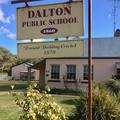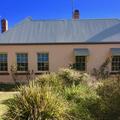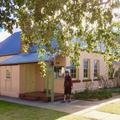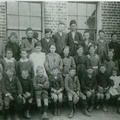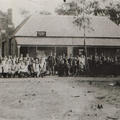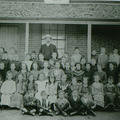< Early Canberra Government Schools
Dalton Public School [1860 - 2018]
Previous Name/s: Wesley Vale
In 1858 the small farming settlement of 'Wesley Vale' along the Jerrawa Creek found that they could fulfil the conditions for the establishment of a school. Mostly Wesleyans, their chapel was vacant during the week, and there were enough children needing schooling. It was not until 1860 however that the Wesleyan minister at Yass Reverend William Kelymack applied to the Board of National Education on behalf of Wesley Vale residents for a 'non-vested public school' - for which the Board would supply a teacher if the residents could supply a building and furniture. The chapel was available, and of ample size (forty feet by sixteen) for the anticipated 40 children. A teacher, Mr John Bell, had been arranged, He was a forty-five year old Irishman (but a Wesleyan of course!) who had been teaching for several years at Ashfield in Sydney.
The Board instructed Inspector Forbes to report on the prospects for a Dalton school, and while confirming the need, he recommended that the Board not pay the teacher's salary until suitable furniture was provided and an average attendance of thirty pupils was achieved. These recommendations were accepted in February 1861. Reverend Kelymack advised the Board however that Bell had already been teaching since October 1860, and argued he should be paid accordingly, although furniture was not supplied until February or March 1861. The Board ordained that he should be paid from the time attendance reached 30; happily this was in October 1860 when Bell began teaching.The school board at this time was composed on Thomas Skewes, William Brown and Thomas Brown. Skewes was to be come the second teacher.
In 1862 the Inspector reported on the school as follows:
'A good slab building well plastered inside. There is a good supply of furniture, but not of a suitable character. Additional maps are needed. Doors required to the outhouses.
The pupils are fairly punctual and regular in attendance; are clean in person, and becomingly attired. The order is tolerable; the government is scarcely rigid enough.
The subjects fairly accord with the Table of Minimum Attainments. The Methods are as satisfactory as would be expected from an untrained teacher. The proficiency of the pupils is small'.
The school was initially called Wesley Vale, but by 1865 was universally known as Dalton. In between there seems to have been some disagreement or equivocation. The school continued to be run in the Wesleyan chapel for which the church received ₤10 pa from the Board of Education. By the mid-seventies however the pressure was growing for a 'proper' school, but residents were unable to raise a third of the expected cost. A Dalton site had been selected by Inspector McIntyre in 1868, without consulting the residents.
Inspector Murray visited in May 1876 and his recommendation was that the school should be located where it was most central for the whole district. This he claimed was Jerrawa Creek, about one and a half miles west of Dalton, where the road crossed the creek. This was accepted by the Council of Education, but vociferously rejected by the local school board and Daltonians in general, who believed theirs was a town growing in importance, and that any public buildings should be located there. The local board suggested a compromise - that a new school be established at Felled Timber Creek (just the other side of Jerrawa Creek) as well as Jerrawa.
A Senior Inspector, Mr J Huffey was instructed to enquire as to the best course of action. In summary he reported:
'(2nd August 1877) - The whole population of the locality could be said to reside within a 4 miles radius of the bridge over Jerrawa Creek on the Booroowa Road. Of the 164 children in the area under 14 years of age, one third are under the age of 4 years. However the farms are so situated that the same population may also be described as living with a similar radius of Dalton.
A central school at Jerrawa Creek as recommended by Inspector Murray would roved for the whole locality, but the Felled Timber children would have to cross the creek which, even with a footbridge, would often be uncrossable.
Having carefully considered this matter and all its surroundings, I am decidedly of the opinion that the proper way to provide for the educational wants of the whole locality would be to have two schools - a vested Public School on the Council's site at Dalton and a Provisional School on a site on the left bank of the Felled Timber Creek about four and a half miles from Dalton.
At a meeting of upwards of 40 heads of families held while I was in the locality, I understood that all of the residents would favour such arrangements as are now suggested, while not one person suggested any other site than at Dalton'
In the course of his report Huffer noted that Dalton was a postal village for the whole locality, the C of E was about to erect a church, there was a large store equal to any of those at Gunning, and a resident was about to spend ₤3,000 on the erection of a flour mill. He noted that the non-vested school had been in existence for a long time and on the day of his visit had an attendance of 39 children'.
Huffer's plan was adopted and in 1878 a contract was let for the erection of a brick school room, 24' x 16', with a four roomed attached residence at a cost of ₤900. This was adequate until the late 1880's, when enrolments exceeded sixty pupils. An additional classroom of 18' x 14' was added, and an assistant teacher, Albert Bush, was appointed to look after the younger children. In fact Bush was a pupil-teacher, straight from school, and without any training, expected to learn on the job. After schools hours he received instruction from the teacher in charge. He was a teacher's apprentice.
Dalton's teachers worked to the common 'Standards of Proficiency'. The subject matter to be taught for each class for a particular part of the year was strictly laid down by these standards, and it was the task of the Inspector of Schools to visit annually, examine each child, and establish to what extent the standards had been achieved. Teachers naturally concentrated some what on drilling their pupils in preparation for this ordeal. This rigidity was abandoned with the introduction of the 'new education' after 1905, when teaching was made more 'student-centred' and teachers given more discretion over what they taught and how.
Some teachers found these change very challenging. One Dalton teacher at least was an enthusiast for the new systems of teaching. Mr Alex Muir (1912-1914), a 'truly live wire teacher' had his ideas about teaching history and geography published in the education department's Gazette for the instruction of teachers. He also published an article on grading examples in mathematics from easy to hard, a practice which was to become universally used.
In 1945 the school enrolment was roughly the same as when the school first opened in 1860 - around thirty. At its peak in 1893 the school had ninety-three enrolments, but this fell to around forty in the years after World War I, rising again in the twenties, helped by the closure of the nearby Felled Timber school in 1924. Although numbers dropped as low as six students in 1992, Dalton has survived while other public schools in the district have all closed down - Elizabeth Fields, Blakney Creek, Lade Vale, Jerrawa, Bevendale, and 'Howardville' (a Subsidised school) at Broadway.
'A Tour in the Southern Districts. (FROM OUR TRAVELING CORRESPONDENT.)
DALTON.
Eight miles to the eastward of Gunning lies the small township of Dalton. The first allotments for the formation of this township were sold about the middle of 1862, and some quartz reef's having been discovered nearby, it was thought at one time the place would rapidly go ahead. This prediction, I am sorry to say has not been fulfilled, as it appeared to me on my recent visit to be merely a bush township. Dalton lies at the head of a valley through which several small creeks run, all emptying themselves into the Lachlan River, more generally known around here as the Fish River. The flats along these creeks are good agricultural land, and mostly devoted to wheat growing. The quartz reefs proved very poor, not paying for the crushing, and the person who erected a machine for that purpose went insolvent and now the goldfields are quite deserted and the reserve might well be cancelled.
Vines grow well in the district and are being extensively planted by the farmers. The Wesleyan chapel is a good brick building, but not by any means ornamental. A church is also in course of erection. The public school at present is held in a building rented for the purpose, but is very inadequate in many respects. Tenders have been called for a new building, which will require to be rapidly pushed on with, as the lease of the present schoolhouse is nearly expired, and there is small chance of obtaining any other premises at present. The number of children on the roll is 60, with an average attendance of 45. Mr. J. V. Moore, the teacher is well liked by both children and parents, and the scholars have made good progress under his tuition'.
[Australian Town and Country Journal, 19 January 1878, page 23]
References:
Dalton Public School Centenary 1878 -1978, School Centenary Committee, Dalton, 1978
Dalton Public School 125th Anniversary, 1878 - 2003, Parents and Citizens Association,Dalton, 2003.
Location Map
Related Photos
Teachers
- Bell, Mr John
10/1860 - 08/1863 - Skewes, Mr Thomas
08/1863 - 01/1865 - Roseby, Mr Samuel
01/1865 - 03/1868 - Anderson, Mr Edward
03/1868 - 03/1870 - Creagh, Mr John
03/1870 - 07/1877 - Moore, Mr George
07/1877 - 09/1887 - Hobart, Mr Richard
09/1878 - 11/1888 - Carol, Mr William
11/1888 - 08/1906 - Greenlees, Mr Gavin
08/1906 - 01/1912 - Muir, Mr Alex
01/1912 - 06/1914 - Croxon, Mr William
06/1914 - 07/1914 - Goddard, Mr John
07/1914 - 05/1925 - Wain, Mr Albert
05/1925 - 12/1930 - Willard, Mr Henry
12/1930 - 12/1937 - Roberts, Mr Fred
12/1937 - 04/1944
NSW Government schools from 1848
- Dalton Public School (external link)
< Early Canberra Government Schools
If you are able to assist our work of identifying, documenting, and celebrating the early bush schools of the Canberra region, please contact us or .


